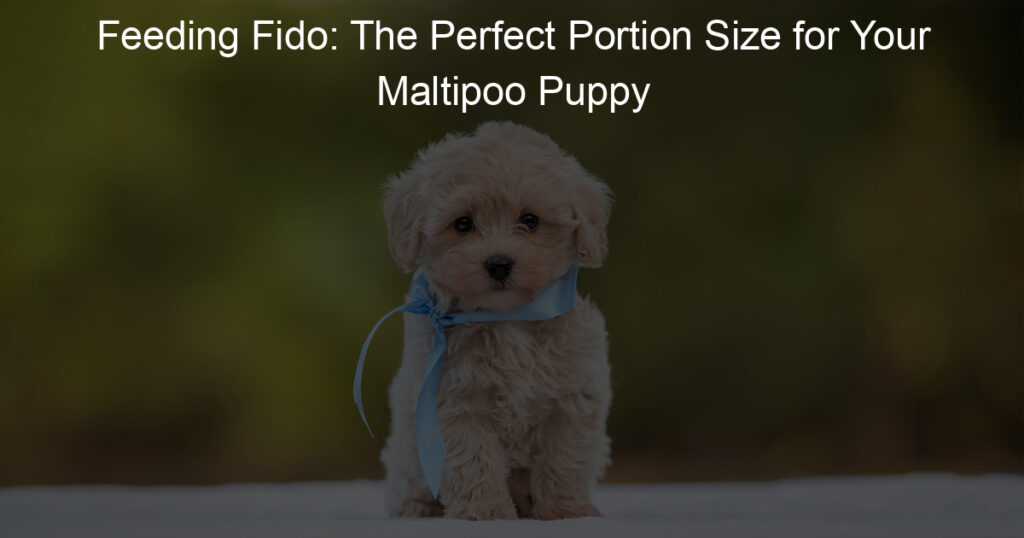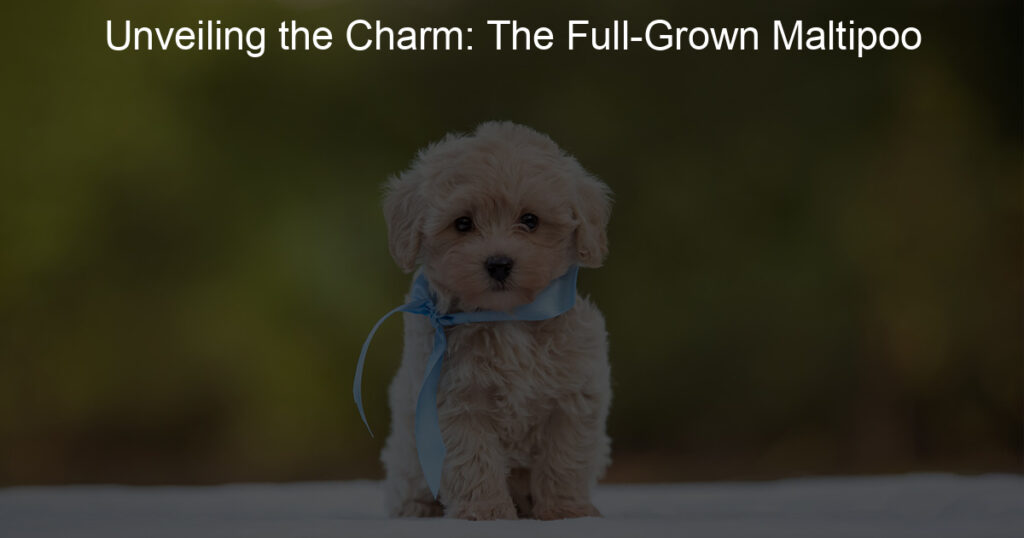
Introduction to Maltipoo Weight Guide
Welcome to our comprehensive guide on Maltipoo weight. This guide aims to provide you with all the necessary information to ensure your Maltipoo maintains a healthy weight. Let’s dive in!
-
Understanding the Importance of Maintaining a Healthy Weight for Your Maltipoo
Just like humans, maintaining a healthy weight is crucial for your Maltipoo’s overall health. A healthy weight ensures that your Maltipoo is at a lower risk of developing health issues such as diabetes, heart disease, and joint problems. It also ensures that your furry friend has a high quality of life, full of energy and happiness.
According to a study by the Association for Pet Obesity Prevention, over 56% of dogs in the United States are overweight or obese. This alarming statistic highlights the importance of understanding and maintaining your Maltipoo’s ideal weight.
-
Common Misconceptions About Maltipoo Weight
There are several misconceptions about Maltipoo weight that can lead to unhealthy practices. One common misconception is that a chubby Maltipoo is a healthy Maltipoo. This is not true. Excess weight can lead to various health problems and reduce your pet’s lifespan.
Another misconception is that all Maltipoos should weigh the same. The truth is, the ideal weight for a Maltipoo varies based on factors such as age, sex, and individual metabolism. Therefore, it’s essential to consult with a vet to determine the ideal weight for your specific Maltipoo.
Identifying Maltipoo Health Issues Related to Weight
As a Maltipoo owner, it’s important to understand that your pet’s weight can significantly impact their overall health. Both underweight and overweight conditions can lead to various health issues. In this section, we’ll focus on the symptoms of an underweight Maltipoo.
Underweight Maltipoo Symptoms
Recognizing the signs of an underweight Maltipoo is the first step towards ensuring your pet’s health. Here are the most common symptoms:
- Visible ribs, spine, and hip bones: If your Maltipoo’s bones are clearly visible, it’s a sign that they may be underweight. A healthy Maltipoo should have a layer of fat over their ribs, making them feel but not see.
- Lack of energy and lethargy: Maltipoos are typically energetic and playful. If your pet seems lethargic or uninterested in activities they usually enjoy, they might be underweight.
- Loss of muscle mass: Muscle mass is crucial for a dog’s strength and agility. If your Maltipoo is losing muscle, it could be a sign that they’re not getting enough nutrients.
- Coat and skin problems: A healthy coat is a sign of good health in dogs. If your Maltipoo’s coat is dull, dry, or patchy, or if they have skin problems, it could indicate that they’re underweight.
These symptoms are serious and should not be ignored. If you notice any of these signs, it’s important to consult with a vet immediately. They can provide a proper diagnosis and guide you on how to help your Maltipoo gain weight healthily.
Overweight Maltipoo Symptoms
It’s essential to identify the signs of an overweight Maltipoo early to prevent health complications. Here are some common symptoms to watch out for:
- Difficulty in Breathing and Exercising: If your Maltipoo is panting excessively or struggling to keep up during walks, it could be a sign of being overweight. Overweight dogs often have difficulty moving around and may tire easily.
- Excess Body Fat: A clear sign of an overweight Maltipoo is excess body fat. If you can’t feel your dog’s ribs or spine when you pet them, it might be time to consult your vet about a weight management plan.
- Development of Diseases: Overweight Maltipoos are at a higher risk of developing serious health conditions like diabetes and arthritis. If your Maltipoo is showing signs of these diseases, such as increased thirst or difficulty moving, it’s crucial to seek veterinary advice immediately.
Remember, these symptoms may not always mean your Maltipoo is overweight. It’s always best to consult with a professional vet to ensure your pet’s health and wellbeing.
Weight Watchers for Dogs: Maintaining Maltipoo Weight
Keeping your Maltipoo at a healthy weight is crucial for their overall health and well-being. This involves understanding their nutritional needs, feeding them the right food and portions, and maintaining a regular feeding schedule. Let’s delve into these aspects in detail.
Maltipoo Diet Plan
Creating a diet plan for your Maltipoo requires a good understanding of their nutritional needs, the right food and portion sizes, and the importance of a regular feeding schedule.
- Understanding the nutritional needs of your Maltipoo: Maltipoos, like all dogs, require a balanced diet to stay healthy. This includes proteins for muscle development, carbohydrates for energy, fats for a shiny coat and skin health, and vitamins and minerals for overall well-being. Always consult with your vet to understand your Maltipoo’s specific nutritional needs.
- Recommended food and portion sizes: High-quality dog food, specially formulated for small breeds, is generally recommended for Maltipoos. The portion size depends on your dog’s age, weight, and activity level. Puppies usually require more food than adults due to their rapid growth and high energy levels. A general rule of thumb is to feed your Maltipoo 40 calories per pound of body weight. However, it’s best to consult with your vet for personalized advice.
- Importance of regular feeding schedule: Regular feeding schedules help regulate your Maltipoo’s digestion and prevent overeating. Puppies should be fed three to four times a day, while adults should be fed twice a day. Stick to the same feeding times each day to help your Maltipoo understand when it’s time to eat and prevent begging for food at other times.
Remember, a healthy diet is the first step towards maintaining your Maltipoo’s weight. Always consult with your vet before making any changes to your Maltipoo’s diet.
Maltipoo Exercise Routine
Exercise is a crucial part of your Maltipoo’s health and weight maintenance. Regular physical activity helps to keep your Maltipoo fit, happy, and at a healthy weight. Let’s explore the recommended daily exercise for a Maltipoo and some fun exercise ideas to keep your furry friend engaged.
- Recommended Daily Exercise for Maltipoo
- Fun Exercise Ideas for Your Maltipoo
- Fetch: A simple game of fetch can keep your Maltipoo engaged and active. It also helps to strengthen their muscles and improve coordination.
- Tug of War: This is another fun game that provides a good workout for your Maltipoo. Just make sure the tug toy is gentle on their mouth.
- Hide and Seek: Hide treats or toys around your home or garden and let your Maltipoo find them. This game provides both physical exercise and mental stimulation.
- Agility Training: Set up a simple agility course in your backyard. It can include obstacles to jump over, tunnels to crawl through, and poles to weave around. Agility training is a great way to burn off energy and it also helps to improve your Maltipoo’s agility and confidence.
Experts recommend that Maltipoos should have at least 30 to 60 minutes of exercise each day. This can be divided into two or three shorter walks, along with some playtime. Remember, the intensity of the exercise should be appropriate for your Maltipoo’s age and health condition. Puppies and younger dogs generally have more energy and may require more playtime and exercise. Older dogs, on the other hand, may not be as energetic but still benefit from regular short walks. Always consult with your vet to understand the best exercise routine for your Maltipoo.
Keeping exercise fun and engaging is essential for your Maltipoo. It not only keeps them physically active but also provides mental stimulation. Here are a few fun exercise ideas:
Remember, every Maltipoo is unique and what works for one might not work for another. It’s important to observe your Maltipoo during exercise to ensure they are not overexerting themselves. Always make sure to provide plenty of fresh water during and after exercise. With the right balance of diet and exercise, your Maltipoo can maintain a healthy weight and lead a happy, active life.
Signs of Underweight Dogs: Not Just a Maltipoo Problem
While this guide focuses on Maltipoos, it’s important to understand that being underweight is a problem that can affect any breed of dog. Recognizing the signs and understanding the risks associated with underweight dogs is crucial for all dog owners.
- Recognizing signs of underweight in different breeds
Every breed has its own ideal weight range, but there are some universal signs that your dog may be underweight. These include:
- Visible ribs, hip bones, and spine: While some breeds naturally have a lean build, you should not be able to see your dog’s bones protruding through their skin.
- Lack of energy: Underweight dogs often lack the energy to play or exercise. If your usually active dog is suddenly lethargic, it may be a sign they’re not getting enough nutrients.
- Dull coat: A healthy dog should have a shiny, thick coat. If your dog’s coat is dull, thin, or patchy, it may be a sign they’re underweight.
- Understanding the risks of underweight dogs
Being underweight can pose serious health risks to your dog. These include:
- Weak immune system: Underweight dogs often have weakened immune systems, making them more susceptible to illnesses and infections.
- Developmental problems: For puppies, being underweight can lead to developmental problems. They may not grow to their full size, and their organs may not develop properly.
- Decreased lifespan: In severe cases, being underweight can shorten a dog’s lifespan.
It’s important to consult with a veterinarian if you suspect your dog is underweight. They can provide a proper diagnosis and recommend a diet plan to help your dog reach a healthy weight.
Maltipoo Feeding Guidelines: Ensuring Your Pooch’s Weight is on Track
Feeding your Maltipoo properly is crucial for their health and happiness. This section will guide you on how often you should feed your Maltipoo, understanding portion sizes, and when to consult a vet about your Maltipoo’s weight.
- How often should you feed your Maltipoo
- Understanding portion sizes
- When to consult a vet about your Maltipoo’s weight
Feeding frequency depends on your Maltipoo’s age. Puppies need to eat more often – about 3 to 4 times a day. As they grow older, you can reduce this to 2 meals a day. Regular feeding helps maintain their energy levels and keeps their metabolism stable.
Portion sizes are equally important. The amount of food your Maltipoo needs can vary based on their age, size, and activity level. Generally, an adult Maltipoo should eat about 1/2 to 1 cup of high-quality dry food a day, divided into two meals. Puppies may need slightly more. It’s best to check the feeding guide on your dog food package or consult your vet.
Regular vet check-ups are essential for monitoring your Maltipoo’s weight. If you notice sudden weight gain or loss, changes in appetite, or signs of discomfort during meals, it’s time to consult your vet. They can provide professional advice and rule out any potential health issues.
Remember, a balanced diet and regular exercise are key to keeping your Maltipoo healthy and at an ideal weight. Always consult your vet if you have any concerns about your Maltipoo’s weight or diet.
Conclusion: Ensuring a Healthy and Happy Maltipoo
In conclusion, the health and happiness of your Maltipoo are largely dependent on two key factors: regular vet check-ups and a healthy lifestyle. Let’s delve into these two aspects further.
- The importance of regular vet check-ups
- Encouraging a healthy lifestyle for your Maltipoo
Regular vet check-ups are crucial for your Maltipoo’s health. These visits allow the vet to monitor your pet’s weight and overall health, and detect any potential health issues early. Early detection of health problems, such as weight-related issues, can make a significant difference in the treatment and prognosis. According to a study, pets that receive regular vet check-ups have a higher chance of living longer and healthier lives.
A healthy lifestyle is equally important for your Maltipoo. This includes a balanced diet, regular exercise, and mental stimulation. A balanced diet ensures your Maltipoo gets the necessary nutrients for growth and maintenance. Regular exercise helps keep your Maltipoo’s weight in check and promotes cardiovascular health. Mental stimulation, through toys and interaction, keeps your Maltipoo’s mind sharp and reduces the risk of behavioral problems.
In essence, the key to a healthy and happy Maltipoo lies in regular vet check-ups and a healthy lifestyle. By adhering to these, you can ensure your Maltipoo lives a long, healthy, and fulfilling life.








